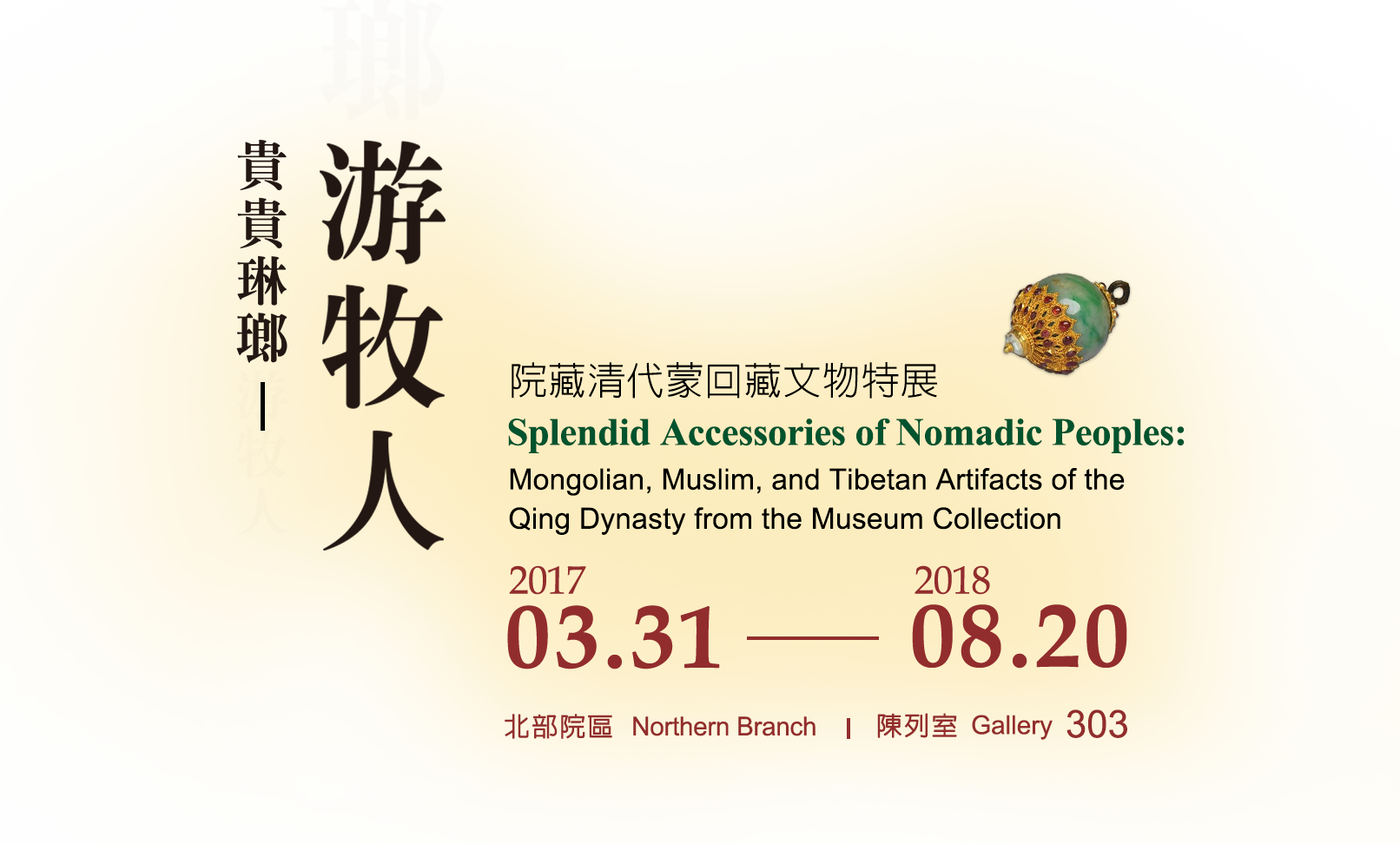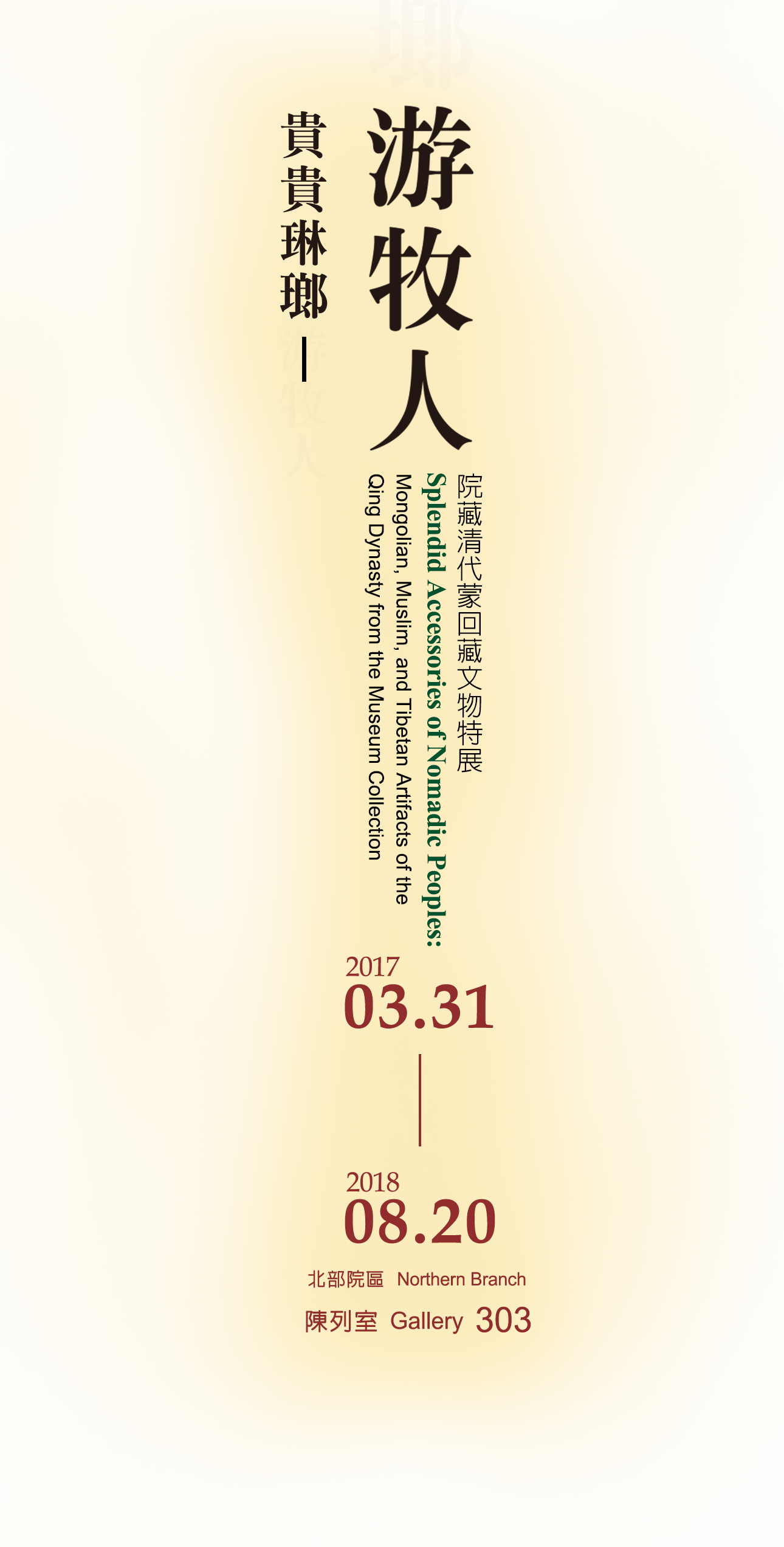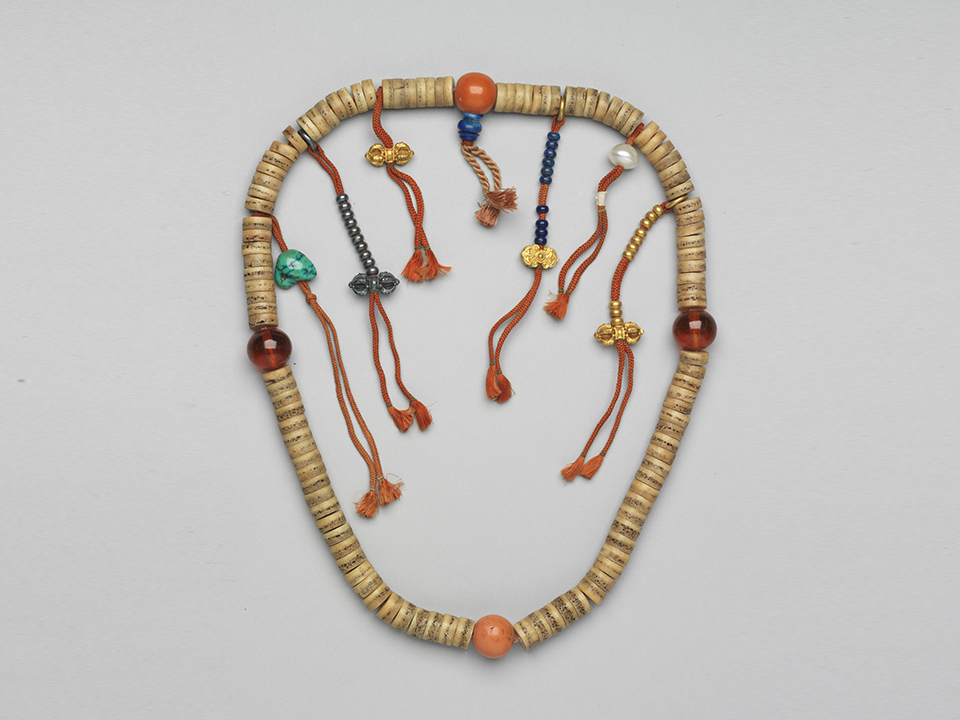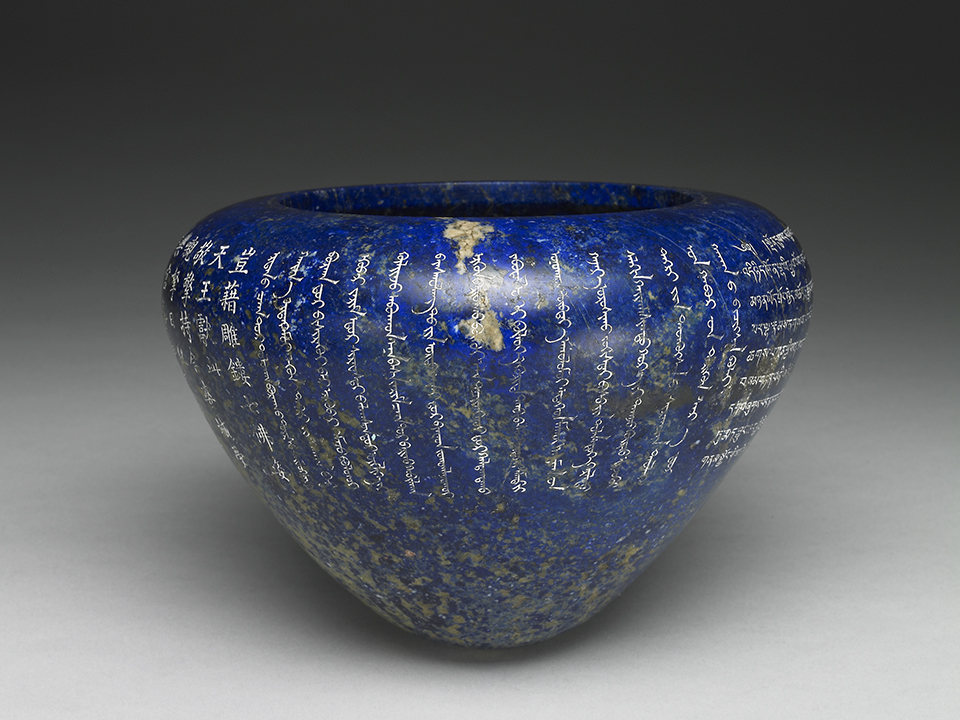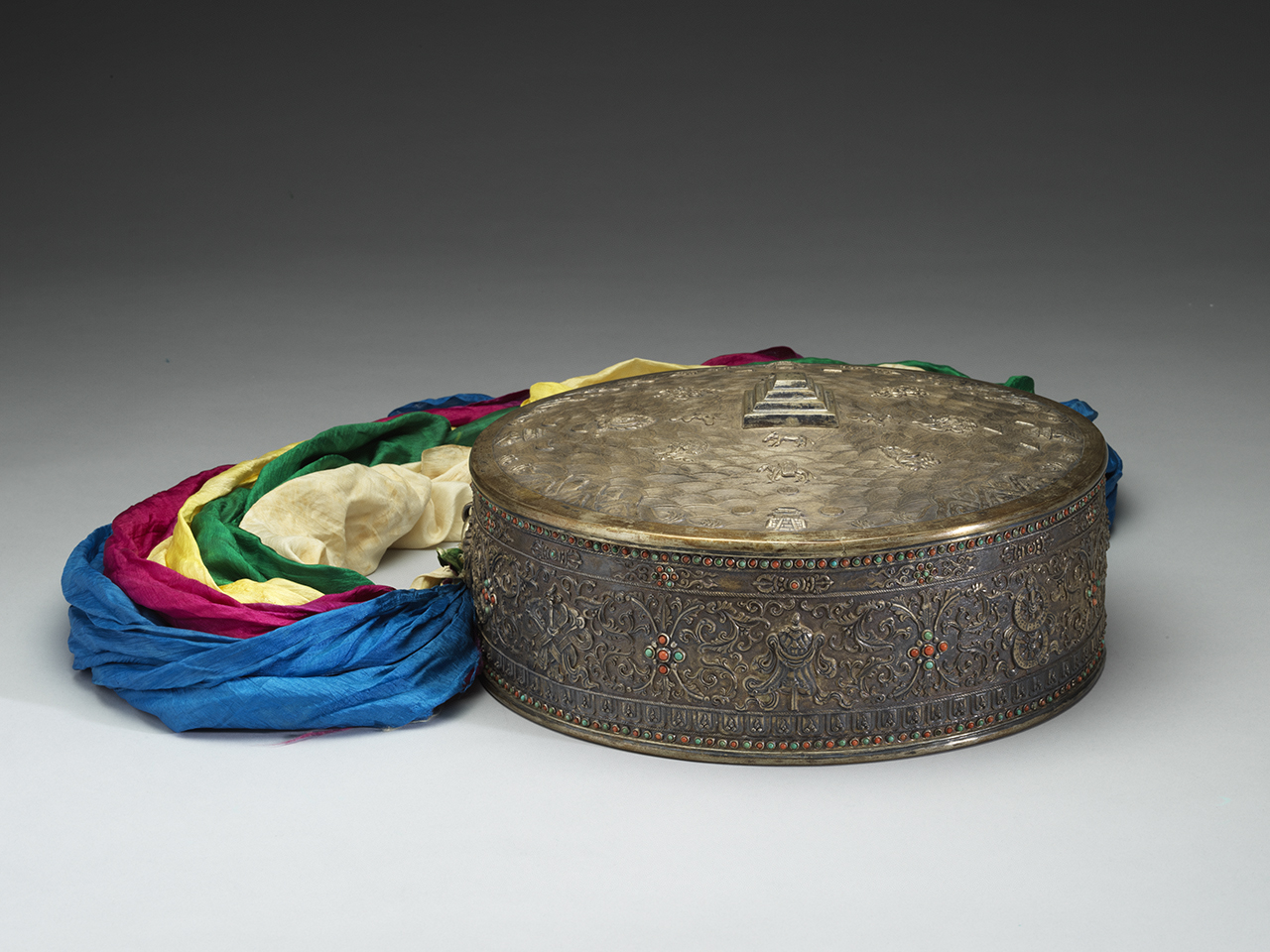Tibetan Buddhism traces its roots to an amalgamation of Indian Buddhism and the original Bon, an indigenous belief system in Tibet. Flourishing by the fifteenth century, Tibetan Buddhism became an important part of Mongolian and Tibetan thought and life, also coming to assert an influence on the Manchu people. Not only were Tibetan monasteries centers of religion, they also were vital focal points for local administration and the economy. For this reason, the tribute items sent by Tibetan lamas and nobility to the Qing dynasty court were always the finest in terms of quality. They invariably submitted Buddhist religious implements as gifts because of their constant reference to the Qing emperor in Tibetan diplomatic letters as "Manjusri," the Bodhisattva of Wisdom. The Qing emperors likewise paid homage to Tibetan Buddhism, demonstrating the high level of importance attached to its influence and the accompanying esteem that it earned as a result.
Bone prayer beads
- Presented by the Panchen Erdeni to the Qing court in 1780
- Qing dynasty, 18th c.
Prayer beads, also called counting beads, are used as an aid in Buddhism, Islam, and Catholicism when reciting scriptures, saying incantations, and reading titles. The bone prayer beads shown here were offered by Lobsang Palden Yeshe (the 6th Panchen Lama) to Emperor Gaozong of Qing in 1780 when the emperor was 70 years of age. In July of the said year, the 6th Panchen Lama visited the Rehe Mountain Resort and stayed in the Tashi Lhunpo Monastery. Accordingly, the Qing court constructed the Xumi Fushou Temple. On the 6th and 24th day of the eighth month, Emperor Gaozong of Qing visited the temple to burn joss sticks. In 1751, the Qing court conferred political power to the 7th Dalai Lama, mandating that the Dalai Lama regularly go on pilgrimages and periodically visit China's capital city during the emperor's birthday. The 6th Panchen Lama was one of the three Dalai Lamas who visited the capital during the Qing dynasty, an event marked as a grand occasion at the time. The prayer beads exhibited here were made from human bones and contain beeswax, coral-made Buddha head beads, lapis lazuli Buddhist pagodas, turquoise, crystals, and gold and silver vajras gadas, exemplifying the solemnness and magnificence of Tibetan prayer beads in the eighteenth century.
Lapis lazuli alms bowl and leather case
- Qianlong imperial inscription dated to 1759, Qing dynasty, 18th c.
- Probably a Tibetan work
The lapis lazuli alms bowl and leather case displayed here is bright in color, rounded in shape, and solemn in appearance. According to the records found on the leather case used to hold the alms bowl, the said bowl was a trophy taken from Dzungar people after they were defeated by the Qing army in 1755; the Dzungar people were surmised to have obtained such a bowl earlier in Tibet. A total four languages (i.e., Manchu alphabets, Chinese characters, Mongolian scripts, and Tibetan alphabets) inscribed by Emperor Gaozong of Qing can be found on the alms bowl. The Mongolian Dzungar people, whose capital city was Ili and who believed in Tibetan Buddhism, emerged in the seventeenth century. They once invaded Tibet and ruled Lhasa and Tibet for three years (i.e., 1717–1720). In 1741, Emperor Gaozong of Qing bestowed an iron bowl upon the Mongolian Jebtsundamba (currently in the collection of the Winter Palace of the Bogd Khan), which shares an identical design with the National Palace Museum's iron bowl with an old crane feather design (presented at the current exhibition). The iron bowl with an old crane feather design involved plating the colors of bluish purple on iron. In the Imperial Workshop Archives of the Yongzheng Era, a number of records on the making of colored spoons and chopsticks with an old crane feather design can be found. Therefore, the lapis lazuli alms bowl and leather case may have been fabricated by using the lapis lazuli (because of its unique color) and by imitating the design of the iron bowl with an old crane feather design.
Silver mandala with multicolored khatas
- Presented by the Tuguan Hutuktu, et al., to the Qing court
- Qing dynasty, 19thc.
- Tibetan work
The silver mandala with multicolored khatas was presented by Tuguan Hutuktu (1839–1894), the 6th Lama of the Gönlung Jampa Ling Monastery (in Qinghai) who stayed in China's capital city, to Empress Dowager Cixi on her birthday. The mandala symbolizes the Buddhist world; the surface of the mandala was engraved with wave-like text, whereas the center of the mandala contains a four-story square platform. Mount Sumeru, which represents the center of the universe, is found in the axis, whereas Mount Akravada-Parvata is observed covering the circumference of the surface. On the four sides of the mountains are city gates, which represent the four continents of Pūrva-videha, Jambudvīpa, Aparagodānīya, and Uttarakuru (the continents are represented by the symbols of circle, triangle, moon-like shape, and square, respectively). On the surface of the sea is a circle of garden stonecrop, whereas on the four sides of the sea are various objects (i.e., a moon, treasure bowl, sun, and ox) used to worship the Buddha. The outer edges of the sides of the mandala were embedded with corals and turquoise in lianzhu (connected circle) patterns, in which vajras gadas and lotus petals were used as decorations. In the center are rolled leave patterns separated from garden stonecrop; the center of the rolled leaf patterns shows a cross-shaped design comprising corals and turquoise beads. The patterns and workmanship of this artifact are awe-inspiring and embody a hint of Chinese styles, making it different from other Tibetan artifacts created during the eighteenth century.
